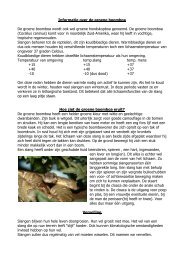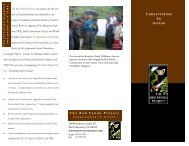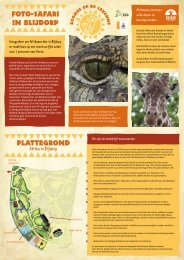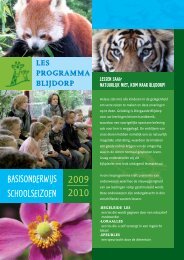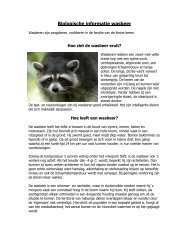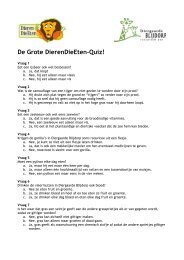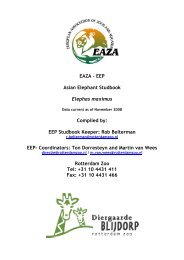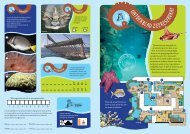European studbook for the giraffe eep
European studbook for the giraffe eep
European studbook for the giraffe eep
Create successful ePaper yourself
Turn your PDF publications into a flip-book with our unique Google optimized e-Paper software.
Hybrid Giraffes and Giraffes of unknown origin<br />
The major achievement in <strong>the</strong> <strong>giraffe</strong> EEP during 2008 was without doubt <strong>the</strong> decrease in <strong>the</strong><br />
population of hybrid and unknown origin <strong>giraffe</strong>s; this decreased by no less than 11 animals (6%)!<br />
This is <strong>the</strong> result of <strong>the</strong> strategy to place as many hybrids and unknown origin <strong>giraffe</strong>s as possible<br />
outside breeding situations. In <strong>the</strong> past years <strong>the</strong> growth already slowed down and eventually also<br />
stopped, but 2008 is <strong>the</strong> year where <strong>the</strong> phasing out also can be seen in <strong>the</strong> figures.<br />
Still 28 (11.17) <strong>giraffe</strong>s were born in this category, of which eleven (4.7) did not survive (39%). A<br />
total of 22 (6.16) were moved between EAZA institutions. Four <strong>giraffe</strong>s (3.1) left <strong>the</strong> EEP. Finally 18<br />
(4.14) hybrid and unknown origin <strong>giraffe</strong>s died.<br />
It is tried to determine <strong>the</strong> subspecific status of <strong>the</strong> unknown origin <strong>giraffe</strong>s to reduce <strong>the</strong>ir number.<br />
Fur<strong>the</strong>rmore it is <strong>the</strong> goal to phase out <strong>the</strong> hybrids by reducing <strong>the</strong>ir reproduction by establishing<br />
single sex groups. In 2005 <strong>for</strong> <strong>the</strong> first time <strong>the</strong> number of hybrid and unknown origin <strong>giraffe</strong>s<br />
decreased. That could not be continued in 2006 and 2007, but <strong>the</strong> growth was in both years lower than<br />
<strong>the</strong> growth of <strong>the</strong> total population. In 2008 a net decrease was again realised. This is expected to<br />
continue and go faster in <strong>the</strong> years to come. In 2008 a lot of hybrids were placed in single sex groups<br />
in Antwerp/BE, Blackpool/GB, Dalton-in-Furness/GB, Ebeltoft/DK, Gdansk/PL, Lisieux/FR,<br />
Malton/GB, Peaugres/FR and Riga/LV and <strong>the</strong>re<strong>for</strong>e less and less of <strong>the</strong>se <strong>giraffe</strong>s are in breeding<br />
situation.<br />
As at <strong>the</strong> moment <strong>the</strong> populations of Baringo <strong>giraffe</strong>s, Reticulated <strong>giraffe</strong>s and Kordofan <strong>giraffe</strong>s are<br />
doing well and as <strong>the</strong> number of new holders is not increasing that fast anymore, we need to decrease<br />
<strong>the</strong> hybrid <strong>giraffe</strong> population as soon as possible, by removing as many hybrids as possible from a<br />
breeding situation and replace <strong>the</strong>m by pure <strong>giraffe</strong>s. It needs to be stated that <strong>the</strong> problem is a bit<br />
smaller than it seems, as several hybrid females are under birth control, like PZP.<br />
24




